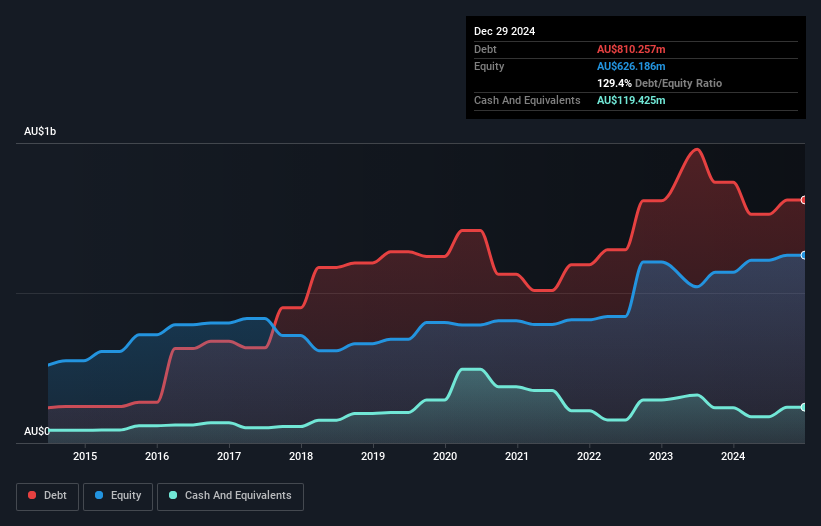- Australia
- /
- Hospitality
- /
- ASX:DMP
Domino's Pizza Enterprises (ASX:DMP) Takes On Some Risk With Its Use Of Debt
Howard Marks put it nicely when he said that, rather than worrying about share price volatility, 'The possibility of permanent loss is the risk I worry about... and every practical investor I know worries about.' When we think about how risky a company is, we always like to look at its use of debt, since debt overload can lead to ruin. We note that Domino's Pizza Enterprises Limited (ASX:DMP) does have debt on its balance sheet. But should shareholders be worried about its use of debt?
When Is Debt A Problem?
Generally speaking, debt only becomes a real problem when a company can't easily pay it off, either by raising capital or with its own cash flow. Part and parcel of capitalism is the process of 'creative destruction' where failed businesses are mercilessly liquidated by their bankers. However, a more common (but still painful) scenario is that it has to raise new equity capital at a low price, thus permanently diluting shareholders. Of course, debt can be an important tool in businesses, particularly capital heavy businesses. When we think about a company's use of debt, we first look at cash and debt together.
How Much Debt Does Domino's Pizza Enterprises Carry?
You can click the graphic below for the historical numbers, but it shows that Domino's Pizza Enterprises had AU$810.3m of debt in December 2024, down from AU$868.9m, one year before. However, it also had AU$119.4m in cash, and so its net debt is AU$690.8m.

A Look At Domino's Pizza Enterprises' Liabilities
According to the last reported balance sheet, Domino's Pizza Enterprises had liabilities of AU$632.4m due within 12 months, and liabilities of AU$1.41b due beyond 12 months. Offsetting these obligations, it had cash of AU$119.4m as well as receivables valued at AU$191.0m due within 12 months. So it has liabilities totalling AU$1.73b more than its cash and near-term receivables, combined.
This is a mountain of leverage relative to its market capitalization of AU$2.32b. This suggests shareholders would be heavily diluted if the company needed to shore up its balance sheet in a hurry.
View our latest analysis for Domino's Pizza Enterprises
We measure a company's debt load relative to its earnings power by looking at its net debt divided by its earnings before interest, tax, depreciation, and amortization (EBITDA) and by calculating how easily its earnings before interest and tax (EBIT) cover its interest expense (interest cover). This way, we consider both the absolute quantum of the debt, as well as the interest rates paid on it.
Domino's Pizza Enterprises has a debt to EBITDA ratio of 3.1 and its EBIT covered its interest expense 5.2 times. This suggests that while the debt levels are significant, we'd stop short of calling them problematic. Importantly Domino's Pizza Enterprises's EBIT was essentially flat over the last twelve months. Ideally it can diminish its debt load by kick-starting earnings growth. There's no doubt that we learn most about debt from the balance sheet. But ultimately the future profitability of the business will decide if Domino's Pizza Enterprises can strengthen its balance sheet over time. So if you're focused on the future you can check out this free report showing analyst profit forecasts .
Finally, a business needs free cash flow to pay off debt; accounting profits just don't cut it. So it's worth checking how much of that EBIT is backed by free cash flow. Over the most recent three years, Domino's Pizza Enterprises recorded free cash flow worth 54% of its EBIT, which is around normal, given free cash flow excludes interest and tax. This free cash flow puts the company in a good position to pay down debt, when appropriate.
Our View
Both Domino's Pizza Enterprises's level of total liabilities and its net debt to EBITDA were discouraging. At least its conversion of EBIT to free cash flow gives us reason to be optimistic. Taking the abovementioned factors together we do think Domino's Pizza Enterprises's debt poses some risks to the business. So while that leverage does boost returns on equity, we wouldn't really want to see it increase from here. When analysing debt levels, the balance sheet is the obvious place to start. However, not all investment risk resides within the balance sheet - far from it. We've identified 4 warning signs with Domino's Pizza Enterprises , and understanding them should be part of your investment process.
When all is said and done, sometimes its easier to focus on companies that don't even need debt. Readers can access a list of growth stocks with zero net debt 100% free, right now.
New: Manage All Your Stock Portfolios in One Place
We've created the ultimate portfolio companion for stock investors, and it's free.
• Connect an unlimited number of Portfolios and see your total in one currency
• Be alerted to new Warning Signs or Risks via email or mobile
• Track the Fair Value of your stocks
Have feedback on this article? Concerned about the content? Get in touch with us directly. Alternatively, email editorial-team (at) simplywallst.com.
This article by Simply Wall St is general in nature. We provide commentary based on historical data and analyst forecasts only using an unbiased methodology and our articles are not intended to be financial advice. It does not constitute a recommendation to buy or sell any stock, and does not take account of your objectives, or your financial situation. We aim to bring you long-term focused analysis driven by fundamental data. Note that our analysis may not factor in the latest price-sensitive company announcements or qualitative material. Simply Wall St has no position in any stocks mentioned.
About ASX:DMP
Undervalued with moderate growth potential.
Similar Companies
Market Insights
Community Narratives




